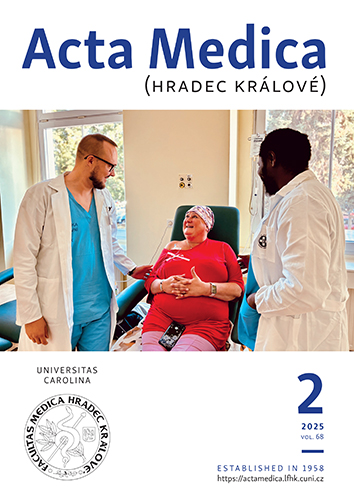ACTA MEDICA, Vol 61 No 2 (2018), 41–46
Tunica Vaginalis Thickening, Hemorrhagic Infiltration and Inflammatory Changes in 8 Children with Primary Hydrocele; Reactive Mesothelial Hyperplasia? A Prospective Clinical Study
Ioannis Patoulias, Evangelia Rachmani, Maria Kalogirou, Kyriakos Chatzopoulos, Dimitrios Patoulias
DOI: https://doi.org/10.14712/18059694.2018.49
published online: 14. 09. 2018
abstract
The aim of this study is to describe an entity of primary hydrocele accompanied with fibrosis, thickening and hemorrhagic infiltration of parietal layer of tunica vaginalis (PLTV). During a 4-year period (2011–2014), 94 boys (2.5–14 years old) underwent primary hydrocele repair. Hydrocele was right sided in 55 (58.5 %), left sided in 26 (28.7%) and bilateral in 12 patients (13.8%). Eighty three out of 94 patients (88.30%) had communicating hydrocele and the rest eleven patients (11.7%) had non-communicating. Our case group consists of 8 patients (8.51%) based on operative findings consistent with PLTV induration, thickening and hemorrhagic infiltration. Preoperative ultrasonography did not reveal any pathology of the intrascrotal structures besides hydrocele. There weren’t hyperechoic reflections or septa within the fluid. Evaluation of thickness of the PLTV was not feasible. Presence of lymph or exudate was excluded after fluid biochemical analysis. Tunica vaginalis histological examination confirmed thickening, hemorrhagic infiltration and inflammation, while there was absence of mesothelial cells. Immunochemistry for desmin was positive, excluding malignant mesothelioma. One patient underwent high ligation of the patent processus vaginalis and PLTV sheath fenestration, but one year later, he faced a recurrence. An elective second surgery was conducted via scrotal incision and Jaboulay operation was performed. The latter methodology was our treatment choice in other 7 out of 8 patients. During a 2-year postoperative follow-up, no other patient had any recurrence. We conclude that in primary hydrocele with macroscopic features indicative of tunica vaginalis inflammation, reversion of the tunica should be a part of operative strategy instead of sheath fenestration, in order to minimize the recurrence.
keywords: hydrocele; boy; tunica vaginalis; inflammation; thickening; fibrosis; hemorrhagic infiltration; Lord Technique

Tunica Vaginalis Thickening, Hemorrhagic Infiltration and Inflammatory Changes in 8 Children with Primary Hydrocele; Reactive Mesothelial Hyperplasia? A Prospective Clinical Study is licensed under a Creative Commons Attribution 4.0 International License.
210 x 297 mm
periodicity: 4 x per year
print price: 150 czk
ISSN: 1211-4286
E-ISSN: 1805-9694
